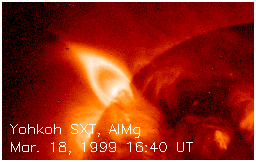

We've seen many cusps before, and there is abundant literature describing this pattern as observed by Yohkoh SXT. In particular people remark that the cusp configuration implies an open field configuration above the bright loops. In this manner oppositely-directed fields would be juxtaposed and magnetic reconnection could occur. Or if not "open" field lines, which makes a statement about solar-wind flow, the geometry would have a great elongation so that a current sheet could form. The reconnection thus expected could in principle feed energy into flare loops following the ejection of a plasmoid - the standard model of eruptive flare development.
Both of these characteristics have been noted before - in the celebrated "candle flame" flare of Feb. 21, 1992, the interior structure appeared to have a cusp shape of its own. The standard model does not include such a structure. As for the planarity of the large-scale cusp: this sounds quite odd from the MHD point of view.

From the individual frames of the image, one can see the pre-event corona in the upper left, followed by dimming and the formation of a tall feature with a frayed top, followed then by the better-organized cusp. The individual frames are labeled with date and time UT. As invariably happens, the cusped feature appears late in the event, grows larger and dimmer, and eventually disappears into the background coronal brightness. These features are all appropriate to the large-scale reconnection picture of the eruptive flare/CME phenomenon.
However, solar rotation gives us different perspectives during the three-day sequence shown, and from this it's clear enough that the cusp feature is not an arcade, but a single loop surmounted by a helmet spike. In fact, several questions arise:
Question #1: If the cusp geometry implies reconnection, why did it develop long after the major energy release (the CME)?
Question #2: What can we make of the structure beneath the cusp - is it evidence for some sort of "tether cutting", in which case should we identify the loops themselves with the plasmoid of the standard model?
Question #3: If the basically 2-dimensional model of inflow into a Petschek-type reconnection is to explain this observation, why is the inflow restricted to such a short arcade (apparently only a single loop structure)?
From the existence of these questions, one can get a feeling for how life is on the frontier of understanding. The favored model sort of works, but does not predict major features of the observations. Is this because the model is essentially wrong, or because the interpretation (based on one person's understanding of the data) is flawed? Stay tuned please, while we sort this out!